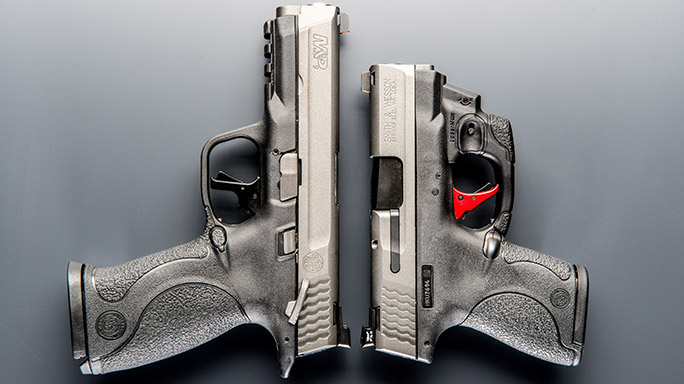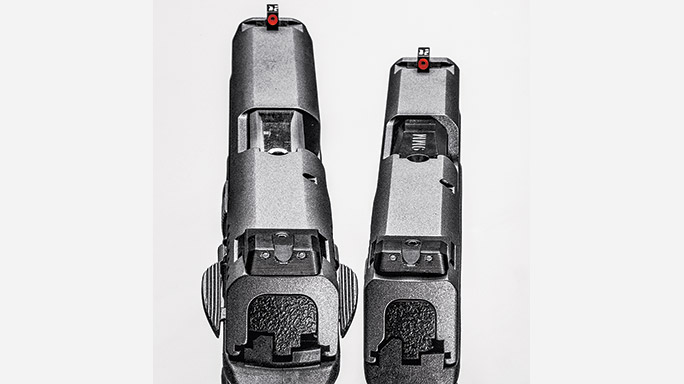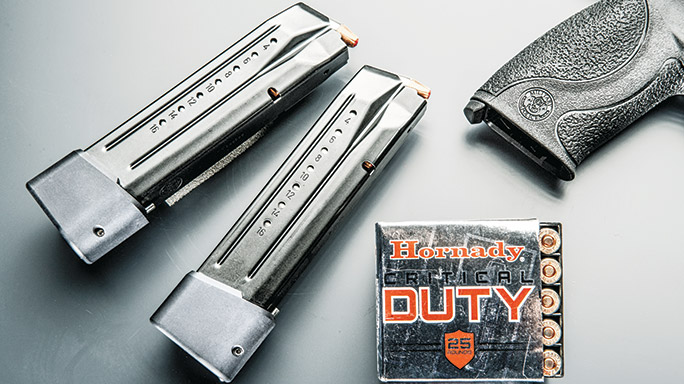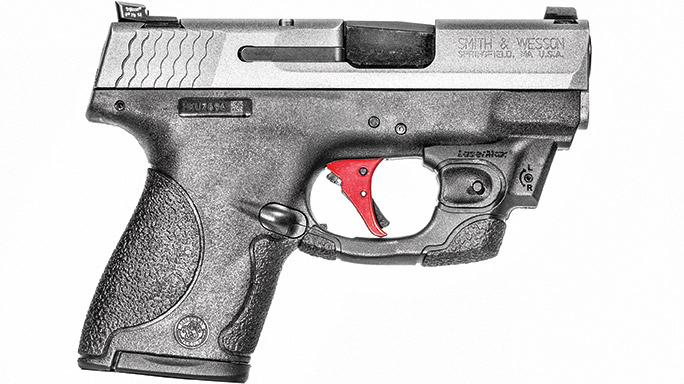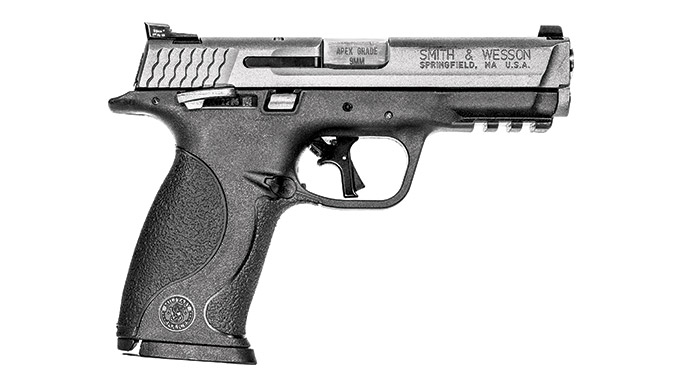For many American shooters, the 9mm has often been viewed as a half measure when compared to the .45 ACP. But that dynamic has been changing in recent years. With many law enforcement departments moving from the .40 S&W round back to the 9mm and ammunition companies developing new technologies that are increasing the performance and power of the cartridge, the 9mm is getting a new lease on life.
- RELATED VIDEO: Smith & Wesson Performance Center’s Ported M&P Shield
In recognition of this fact, I decided to give the 9mm a chance. In my current carry system, I have an all-steel 1911 in .45 ACP that I carry with two spare magazines of ammunition. With one in the chamber, that gives me a total of 22 rounds of ammunition. With a polymer-framed 9mm pistol, I could up that amount significantly with practically no increase in overall weight. But what gun would be the right choice for me?
As a longtime fan of Smith & Wesson guns (having bought a Model 642 in .38 Special as my first carry gun), I decided to look closely at the company’s full-sized M&P9 pistol. First and foremost, I wanted a pistol with an ambidextrous manual safety (as I am a southpaw). Having trained on the 1911, I was comfortable with this type of system and wanted to retain it on my new carry gun. Fortunately for me, Smith & Wesson offers a well-designed manual safety on a wide range of its M&P pistols, including the M&P9. Weighing in at 24 ounces unloaded and offering a 17+1 capacity, the full-sized, thumb-safety-equipped M&P9 fit the bill perfectly for my new CCW project.
Advertisement — Continue Reading Below
While I do currently have the Model 642 as my pocket-carry gun, I decided to go all in on the 9mm and look at an M&P Shield. With this, I would have crossover ammunition compatibility between my primary gun and my secondary gun. As I wanted this primarily for pocket carry, the slim M&P Shield (which features a single-column magazine, albeit slightly staggered to increased capacity) seemed like the best option. With a flush-fitting, seven-round magazine, the M&P Shield is roughly the same size as the Model 642 while packing three more rounds. I selected the model with no thumb safety, as the manual safety on the Shield is non-ambidextrous and I have not yet trained on properly disengaging a safety on my pocket-carry gun before using it.
Reaching The Summit
Next I decided to see about customizing the two guns to fit my specifics needs. With the extreme popularity of the M&P series of pistols, there is a massive cottage industry of enhanced parts and upgrades available out there.
Advertisement — Continue Reading Below
During my research on customizing the Smith & Wessons, one company kept coming up—Apex Tactical Specialties. Having developed a stellar reputation for its work on Smith & Wesson’s M&Ps as well as revolvers, it seemed like a great place to start on this project. I touched base with Apex’s Paul Erhardt and brought him up to speed on my purchases and my goals with the guns.
Having reviewed the options on the company’s website, I had decided that an Apex Level II Trigger Service Package with a Duty/Carry Action Enhancement Kit (DCAEK) and an M&P Aluminum Action Enhancement Trigger would be ideal for the M&P9. However, my conversation with Erhardt opened up some interesting new possibilities.
He said, “We have a new M&P barrel design we have developed in-house. It requires fitting and is designed to give really good accuracy. We are coming out with a new Flat-Faced Action Enhancement Trigger.” When I mentioned that I was setting this up as a carry gun, he explained, “This is not our Forward Set Flat-Faced Trigger, so it would be a solid option for carry if you are a fan of the flat trigger ergonomics. It’s built to fit the M&P and work with our Duty/Carry Kit.”
Advertisement — Continue Reading Below
Our discussion then turned to the Shield. I wanted to do something similar with the Shield as what I had planned with the M&P9. Specifically, I wanted to get the company’s Level IV Trigger Service Package with the DCAEK kit and red replacement trigger. Erhardt said this wouldn’t be a problem and asked me to send the guns along. He explained that Apex would inspect and review the guns and see if there were any other options/enhancements that might be a good fit as well.
As a side note, I do want to point out that Apex Tacitcal’s trigger systems are designed to be user installable, meaning they have a simple drop-in design that many “hobby gunsmiths” could handle themselves. However, with the barrel installation work needed on the M&P9, I decided to go ahead and just send in both pistols for all of the work.
Devil’s In The Details
Advertisement — Continue Reading Below
Now that I had selected the guns and the major work to be done on them, that left me to round out the package with some additional accessories and options. While the M&P9 comes standard with two 17-round magazines, I purchased a third because I usually carry two spare magazines on me. With one in the chamber, that would bring me to a total of 52 rounds.
During my research on the M&P series, I discovered the M&P Firepower Base Pad Kit from Taran Tactical Innovations (TTI). The kit, which includes a one-piece billet aluminum extension along with an “extra-power” replacement spring, increases the capacity of 9mm and .40 S&W M&P magazines to 23 and 20 rounds, respectively. The extension, hardcoat anodized and offered in a range of colors, adds roughly 1 inch of length to a magazine. I ordered two in matte black, bringing my carry system up to a total round count of 64 rounds.
While both pistols come with very serviceable three-dot sights, I decided to upgrade both to Trijicon HD night sights. These rugged, metal-bodied front and rear sights feature tritium dots and a colored ring (in either orange or yellow) around the front sight. This, combined with the serrated and subdued rear sight, enhances your focus on the front sight. Also of note is the flat forward edge of the rear sight, making it suitable for one-handed slide racking. I selected the orange option for both the M&P9 and the M&P Shield.
Advertisement — Continue Reading Below
I also decided to outfit the compact M&P Shield with a LaserMax CenterFire red laser unit. Weighing only 0.7 ounces and clamping around the triggerguard, the unit would give me more flexible aiming options while adding practically no additional bulk or weight.
My last modification to the two guns would be to have the slides and primary controls finished in tungsten-colored Cerakote. Developed by NIC Industries, this thin-film ceramic coating offers a hard finish that is resistant to abrasion, corrosion and chemicals—and looks great at the same time. The thinness (0.001 inches thick) of the coating makes it ideally suited to the often-tight tolerances of firearms. And it can be applied to practically all materials used in firearm construction, be they steel, aluminum or plastic/polymer. While NIC Industries does not do any application work itself, you can check cerakote.com to find a Cerakote-certified applicator.
Hands On
Advertisement — Continue Reading Below
Once I had the two pistols back in hand from Apex Tactical, I reviewed the work that was done and contacted Erhardt to go over the details (and also sent out the pistols for the Cerakote finishing). Erhardt explained to me that the Level II trigger work and DCAEK installation done to the M&P9 is designed to provide an enhanced trigger pull with less overtravel and a shorter reset. The Level II work involves polishing critical bearing surfaces and removing any machining burrs that might be present.
The new flat-faced aluminum enhancement trigger Apex Tactical installed on the M&P9—which features a central safety “paddle” to prevent unintentional firing like the factory trigger—is designed to offer enhanced ergonomics and increased mechanical advantage for the trigger finger. A small recurve at the bottom keeps the finger from drifting too low. With the DCAEK, this trigger is designed to provide a 5- to 5.5-pound pull weight.
Apex Tactical also installed its Fail-Resistant Extractor (FRE). Machined from a solid billet of steel, the FRE is Melonite finished for increased surface hardness. Erhardt told me that its machined hook has a sharper, more-defined engagement surface that more firmly holds onto and positively extracts spent cases. In addition, Apex Tactical fitted the pistol with its Reset Assist Mechanism (RAM), which is designed to provide a more tactile trigger reset. Erhardt explained to me that it also can act as a failsafe if the trigger return spring of the pistol fails. In that case, the shooter can manually pull the trigger forward and then engage it to fire a round.
Advertisement — Continue Reading Below
The new barrel was our next area of discussion. Dubbed the “Apex Grade Barrel,” Erhardt told me it is made from 416 stainless steel and features a 1-in-10-inch rate of twist. He explained that it is designed to provide improved accuracy with 9mm bullets ranging in weight from 115 to 147 grains. The barrel is offered in 4.25- and 5-inch lengths in either “Gunsmith Fit” or “Semi Drop-In” configurations. The latter is designed to drop into roughly 90 percent of all M&P9 pistols with no fitting at all. Erhardt told me that shooters should expect 1-inch or better groups at 25 yards with the Gunsmith Fit model, and 1.5 inches or better with the Semi Drop-In.
On the Shield, Apex Tactical did its Level IV work, which included installing the Apex Fully Machined Sear, Ultimate Striker Block and the Shield Action Enhancement Trigger in red. The intended result is a trigger pull in the 5- to 6-pound range. The new aluminum trigger also has a center-mounted pivoting safety and is designed to reduce pre-travel and overtravel by roughly 20 percent.
Erhardt also sent me some documentation on the trigger pulls of both pistols (both before and after) that Apex Tactical did with a Dvorak TriggerScan System as well as some Ransom Rest testing of the M&P9 with the original and the new barrel. To verify Apex’s results once I had the pistols back in hand, I tested both of the triggers with my own mechanical trigger pull gauge and found them to be accurate. The M&P9’s trigger pull weight was reduced from 7.25 to 5.75 pounds, while the Shield’s trigger went from 8.25 to 6 pounds. The trigger pulls on both pistols were also extremely clean and crisp.
Advertisement — Continue Reading Below
- RELATED VIDEO: Smith & Wesson’s Unique SW1911 Engraved Pistol
To test the M&P9’s accuracy, Apex Tactical ran 115-grain Fiocchi FMJs through the gun at 25 yards while using a Ransom Rest. The original barrel shot a five-round group of 1.87 inches, and the new barrel shot a five-round group of 0.89 inches. To verify, I took both the M&P9 (with both barrels) and the Shield out to the range with some Hornady 135-grain Critical Duty FlexLock ammo for the former and 115-grain Critical Defense FTXs for the latter. Shooting from a sandbag on a bench at 25 yards, the M&P9’s best group with the original barrel was 2.1 inches, while the Apex barrel created a 1.05-inch group. The Shield’s best group measured 1.25 inches at 7 yards. Considering that I was not running the M&P9 with a Ransom Rest, these results appeared to support Apex’s results.
Needless to say, I am very happy with the reworked pistols. All of the customizations make for an impressive new carry combination for me. Packing a total of 72 rounds of 9mm with the M&P9’s 64 rounds and the eight rounds total in the backup Shield, I should be well prepared for any threats I might be forced to face.
For More Information
- Apex Tactical Specialties: apextactical.com; 805-528-5250
- Cerakote Firearm Coatings: cerakote.com; 866-774-7628
- LaserMax: lasermax.com; 800-527-3703
- Smith & Wesson: smith-wesson.com; 800-331-0852
- Taran Tactical Innovations: tarantacticalinnovations.com; 805-522-1911
- Trijicon: trijicon.com; 800-338-0563
Specifications: Apex Tactical S&W M&P9
- Caliber: 9mm
- Barrel: 4.25 inches
- OA Length: 7.63 inches
- Weight: 24 ounces (empty)
- Grip: Polymer
- Sights: Trijicon HD
- Action: Striker-fired
- Finish: Tungsten Cerakote
- Capacity: 17+1 (26+1)
- MSRP: N/A
Specifications: Apex Tactical S&W M&P Shield
- Caliber: 9mm
- Barrel: 3.1 inches
- OA Length: 6.1 inches
- Weight: 19 ounces (empty)
- Grip: Polymer
- Sights: Trijicon HD
- Action: Striker-fired
- Finish: Tungsten Cerakote
- Capacity: 7+1
- MSRP: N/A
